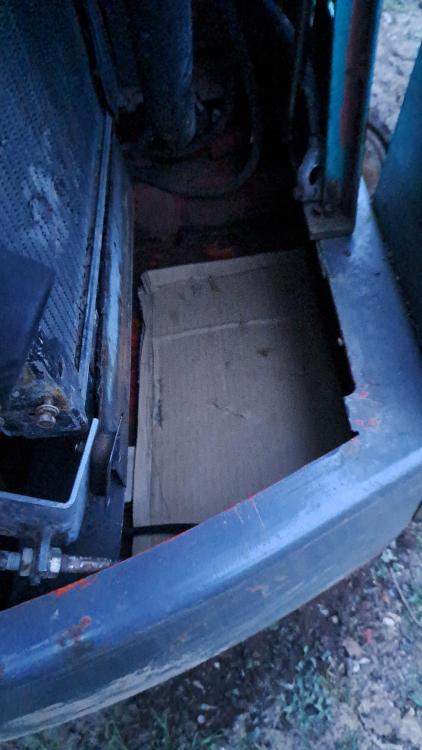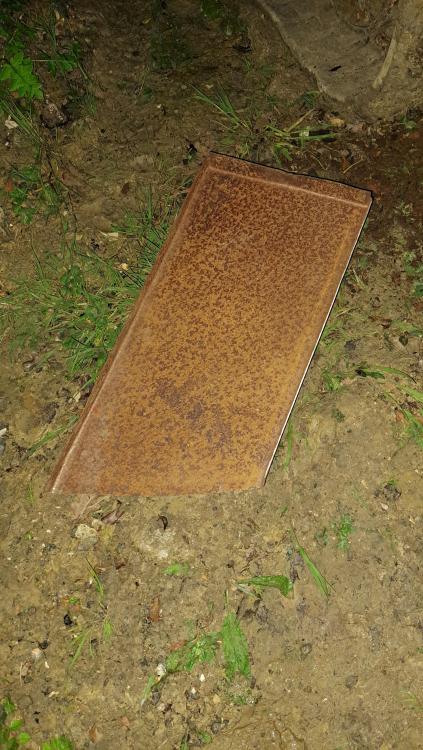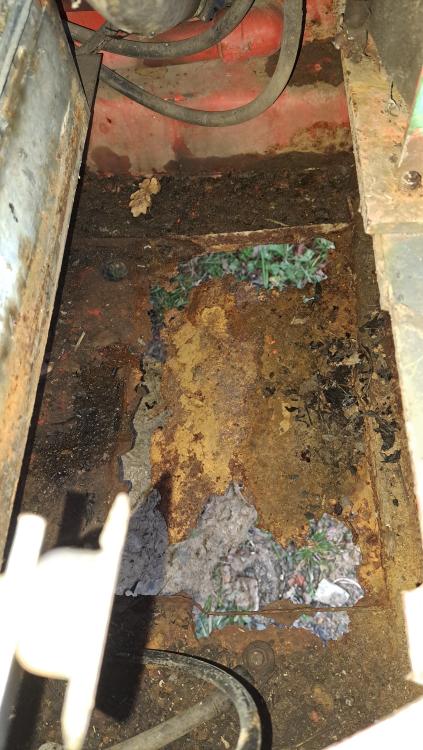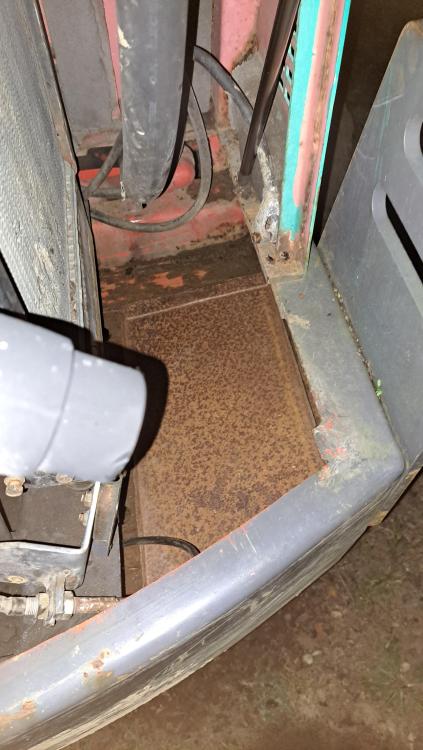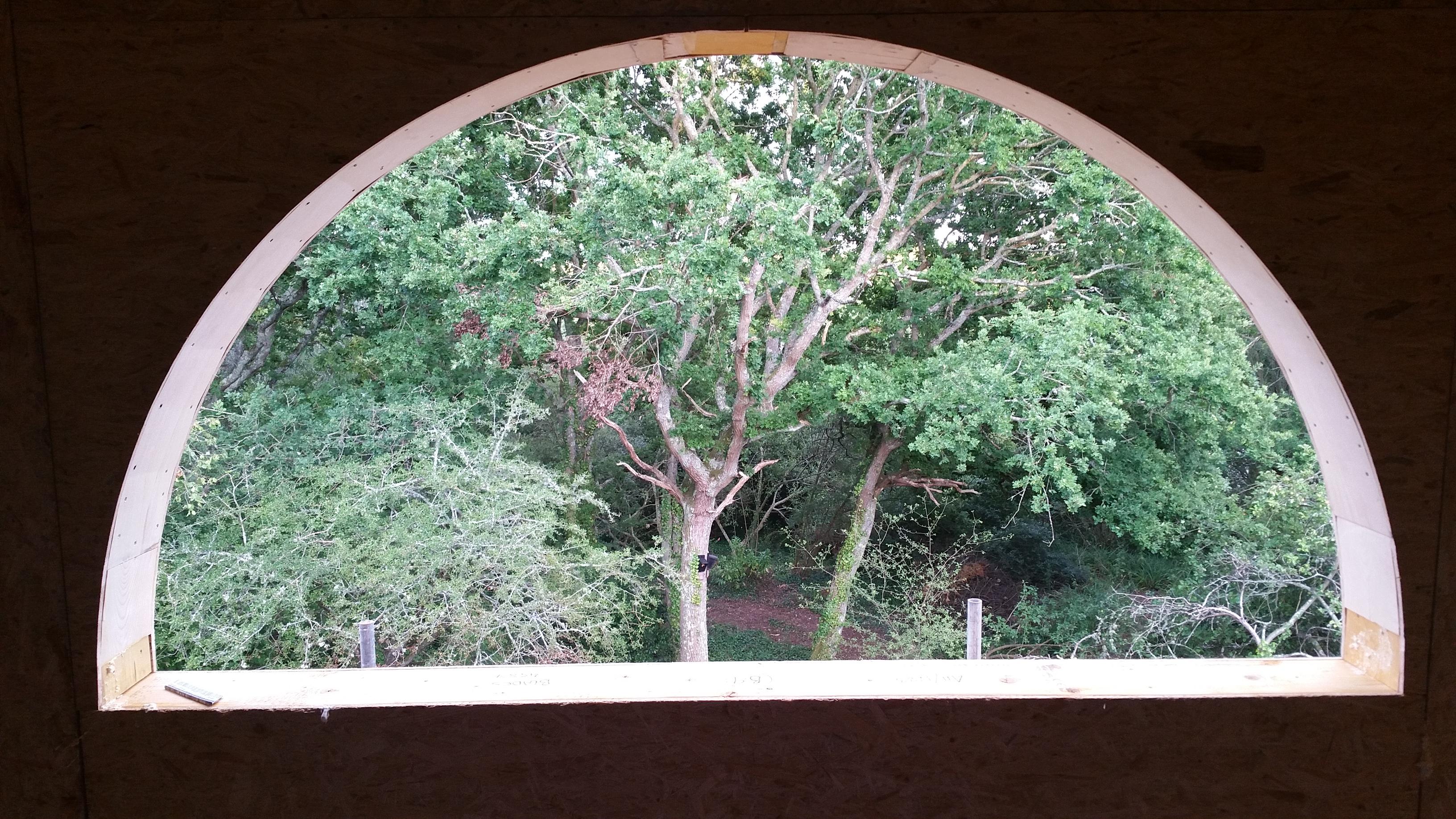
dnb
Members-
Posts
575 -
Joined
-
Last visited
-
Days Won
10
Everything posted by dnb
-
I put up bat boxes, but our local woodpecker population decided they were going to evict the bats. Guess they can't read the endangered list. We are working out the last few details for digging our pond. We have smooth newts so I am hoping they like it
-
Collecting the materials for finishing my roof
dnb replied to dnb's topic in Roofing, Tiling & Slating
The second bit I know... But this very sensivlke advice comes about 4 years late. I'm not changing anything now!! For the record the BCO and warranty folk were happy with the C24 graded 2x1.5 I sourced for reasonable cost, and happy with all of the fixing plans. My understanding is that the documentation has moved on a stage now so perhaps I wouldn't get away with it so easily now, but if that's the case then a product would have become available. @junglejim The BS document isn't freely available. The BSI like you to buy it from them! But you can usually find the useful sections from it in places like a LABC technical guide or NHBC documents. -
I have an rs485 based modbus connection working on cat5e for my solar inverter data. No problems so far.
-
Guessing that the problem here has come from the cavity side and it's only been noticed when the whole frame depth is affected. I am going for a similar theory to @ProDave - something is allowing water into the cavity and it's getting to the back of the frame. Another window (or something) above it without a drip cove on the sill that lets water track into the cavity? The pictures suggest there is no cavity closer for that window.
-
And I thought the 2 lift scaffolding staircase I had was posh! (and very useful for getting stuff up to the top) Is it just me, or did they spend all the money on scaffolding so couldn't afford labour to mix the brick packs up thoroughly?
-
Had a bit of fun playing find the good bits of metal with the MIG and the inevitable running out of wire on Easter Saturday. All together again and back to doing the landscaping. Going to need to do a few more repairs over the next winter I think but all OK for now.
-
Looking good! Finishing this job off myself and can say that Steico do indeed make a very detailed document saying what you can and can't do. I spent ages reworking the design to minimise joist penetrations and keep the holes away from the edges and the other (electrical) constraints - it was like doing circuit board design all over again.
-
I bought mine because I have a lot of work for it that I couldn't do all at once. I'm still "winning" over hiring because the flexibility is worth a lot to me especially when I've had experiences of weeks where there were zero available diggers for hire on the whole island. You can imagine how much they were costing to hire that month, and what the terms for "one more day" were... A bit of servicing and welding every so often isn't so bad if you have the equipment. It's worth highlighing that this sort of repair should be a consideration for running your own plant, especially if you buy an older machine. In hindsight a better cover for the worst of the winter months would have been a good idea.
-
But boring in the extreme! The weekend was the first fine weekend of the year where I was not working. So I put a bit of time into getting the digger serviced and ready for the spring groundworks. During testing it made a bad noise and on removing the battery that was more or less hanging on by the cables found the battery tray was slowly disassembling itself like a 1970s vintage Jaguar! Heaven only knows how the -ve terminal connected to anything through that rust! I resolved to fix the digger that day because it will be good for a biscuit or two in "House not finished anonymous" and the weather looks good for getting some industrial weeding done later in the week. Cardboard will work, won't it? Maybe not the cardboard. It's even less conductive than rust. I found some steel from the stores (read scrap heap). Bends formed with a bit of angle iron and a hammer. And it even fits in the hole. Welding and painting will be done next time I am not at work.
-
For the purposes of thread closure, I have managed to find a sufficient stock of obsolete parts to keep things going for a bit longer for not much cash outlay. In the end it was a degraded sensor wire shorting on to the case causing the PCB problem (they have been replaced and tied up properly), a sick pump start capacitor and a sticky part in the 3 way valve. All of them displaying intermittent symptoms. Cash flow preserved for the moment... Only a small gas fitter bill. I can now get back to all the other broken things I need to fix and think about a plan for insulation improvements and a heatpump should we decide to keep this house.
-
Some progress... we got the pcb working by swapping out the dead VDRs and a fuse. Everything works apart from the ignition spark. Needs new electrodes or coil but that's why there are gas fitters.
-
There is insufficient space between us and the neighbours, plus restrictive covenants to contend with. It's a non-starter unless I had a few months to sort things out with planning and the beneficiary of the covenants. All of it costs and we won't be living here in a few months with any luck.
-
Not been a good day. Our 20+ year old Glowworm Xtramax boiler has died. It made what I can only describe as a "selection of bad noises" when I was in the shower and when I got out to see what was wrong everything was dead - no LCD display, lights or faults. The fuses are all OK, even the one on the PCB but there's no apparent life. Are there any experts on antique Glowworm boilers here that could provide some insight? I would prefer to not have the expense of replacement given we're not going to be here much longer but it might just be better to accept that 20 years of relatively trouble free life is a good for a boiler since a cursory internet search doesn't turn up replacement PCBs (I'm assuming this is the problem given the total lack of life). What is a good economic make & model to replace it with? I dimly remember the spec as 28kW with 50 litres of DHW storage. I'm not convinced our 80s built house works with an ASHP for a number of reasons - efficiency and lack of garden space being the 2 most important - so I am stuck with gas.
-
Low loss headers and plate heat exchangers for air source heat pumps
dnb replied to dnb's topic in Boffin's Corner
Tell me something I don't know... It's one of the reasons I don't see the need to "penny pinch" with a solar diverter and an immersion if I can meaningfully sort out a few hours of storage. I can just take the benefit (small as it is) from offsetting. In the summer I will use the PV for the A/C as well as the DHW. Again, this drives the need to sort out some form of meaningful storage that doesn't hit efficiency too badly. -
Low loss headers and plate heat exchangers for air source heat pumps
dnb replied to dnb's topic in Boffin's Corner
Thanks for a very useful insight. You do recall correctly. This is why I am keen to understand if the gen7 HPs have this trick like their predecessors. It makes quite a difference to the plan. Relevent to this, I found their datasheet quoting the MCS approved SCOP. For the 8kW and 12kW pump it looks like: Temp 8kW 12kW 35°c 4.66 4.73 40°c 4.35 4.42 45°c 4.04 4.12 50°c 3.72 3.82 55°c 3.41 3.51 60°c 3.15 3.17 65°c 2.89 2.84 This is why I am considering if I really need the immersions - if the HP really can deliver a COP way better than an immersion in most of the conditions I may as well not tie it to the solar. I currently see batteries to fill in the holes as still a lot more expensive than just buying electricity if I can get the heat pump, buffering and control system sized and timed correctly on average. This is obviously a tricky problem! I tend to agree here. The MVHR etc will help to even everything out in the house and I'm not setting out to control things by zone other than having a warm towel in the evening even if the heating is nominally off for the purpose of space heating. It's a case of them being there to get ticks in boxes. I don't see a need to deliberately not heat parts of the house when I've spent a lot of time and effort to make it well insulated and air tight. DHW is the main part that's making me consider the plans carefully. The other is separating generating heat from using it may have some timing benefits from using my solar PV. Yes it's more energy used to do the same job, but when much of that energy is "free" and multiplied by a COP greater than 1 then it's a financial win. My annual solar generation should be in the 6.5MWh range so well worth considering. I have the size. It's based on our useage data, multiplied by 5/3 to allow for long term parent visits. This calculation has never been part of the problem other than designers trying to make it smaller. I think I am seeing some of this in the candidate designs. It's dressed up as other things of course. Very useful link. Thank you. Not had time to read much yet this week. Can't see where the week has gone! -
Low loss headers and plate heat exchangers for air source heat pumps
dnb replied to dnb's topic in Boffin's Corner
Thanks. That's new information to me. Suspect assumptions were made on both sides (I spent many years playing with classic cars so "knew" glycol was poisonous) so nobody bothered to talk about the COSHH data. They were the extreme examples. Nothing more. There's an 8kW in the range that might work if I can wait the delivery time. The 12kW does have some advantages if the efficency issues can be managed effectively but if not then there's no point. So you completely discount the Samsung Gen7 R290 heat pump claims of 60 to 70 deg water? Very interested in knowing because it's high on my list. Any suggestions about good sources that aren't sales pitches? General information from Wikepaedia et al. is OK but often doesn't have relevant examples. By what you've said, all of the candidate designs will work. Some will be more efficient than others and until I can model them effectively I am doing little more than rolling dice to decide what to buy. This is what I am trying to tease out from here and my candidate installers. Thanks for the discussion so far. -
Low loss headers and plate heat exchangers for air source heat pumps
dnb replied to dnb's topic in Boffin's Corner
Nail hit on head. It's simpler for the installer. It may not be better for me as the end user. Why will it be a LOT more? Unless you know that Samsung are exagerating with their R290 heat pump performance - they are claiming 65 degC albeit with a low (but still a lot more than unity) COP? Genuinely interested here because something from this range is very high on my list especially if I can get the grant to fund it. Yes, immersion for anything above this, but I don't see there will be a pressing need if the HP manufacturer claims are genuine under real world conditions. Self-utilisation for me. I've got no plans for FIT and I will be paying for electricity to heat the house and the water anyway so I may as well multipy the PV generation by the COP to get best use of energy wherever possible. No point trying to not use power in the day time to find it gets used later in the evening anyway. There's no cheaper energy source available so I can see little point for me in using a PV diverter. The modelling will tell all with this... Not had time write anything for this yet but will share the results when I'm done. Had some work deadlines so my progress on house tasks is slow this week. Yes, but iron oxide and inhibitor feels less toxic and easier to notice than glycol based products. Iinhibitor and iron oxide have always been a house feature so it's "normal" whereas glycol feels like something that should be in the garage slowly leaking out of my TVR so I could be convinced I am concerned over very little. Having a think about the various designs, it looks like the simplest is trying to get a good COP by matching the heat pump size to the 97th (ish) percentile worst case outside temperature and rely on modulation then reduced duty cycle when there is less heating demand such that no buffering should be needed. On the worst case days DHW can only from immersion heaters and one would suspect there is no PV on such days... Simple to install and simple to run, but it's probably the more costly option to run because it appears to make the least effective use of PV. Then the more complex designs try to break the link between supply of heat and use of heat in various ways. It would seem from this thread that some ways are more acceptable than others and whatever happens breaking this link will cost efficiency in some way, so it's critical to minimise the loss and know that the PV can provide a greater benefit. -
Low loss headers and plate heat exchangers for air source heat pumps
dnb replied to dnb's topic in Boffin's Corner
You were advoacting for exactly this with the PV... Requirements decomposition is an integral part of engineering so that pieces can be considered in isolation - I was hoping we could tease out general reasons why the designs look like they do without me having to publish all of them since I haven't sought permission to publish. In theory I should do this. I am trying to select from a number of options. As I said in the second sentence of the first paragraph of the 1st post. Agreed, but not according to Samsung!! I don't belileve them either with the CoP of 4, but the maths still works out the same - using the ASHP when there is "some" PV generation appears to be the more efficient way to operate. Few people seems to be advertising this sort of control yet, which I can understand because heat pumps are still a minority product compared to displacing burning gas. I need to get my home Matlab licence working again to try making a simulation for this based on my PV logging. I never said they were. "One leak away from the DHW" means the coil leaking into the DHW. Not a fan of antifreeze even one exchanger removed from DHW. I strongly implied it did need a buffer. But some of my candidate solutions have one and some don't. I believe the house does need one but need to understand the problem a bit more. Yes, and timing implies size of heat pump. An extreme case - If I need all the output for 24 hours to heat the house then there's no time to do DHW. A more practical case: If there are 4 hours of useful PV on average in the spring and autumn, then the solution may well be to oversize the heat pump such that it has a chance of capturing all the energy we need for the day in those 4 hours (ackknowledging that some energy may be needed from the grid). I fear some of the people I've approached may be selling square wheels. Or octagonal at best. -
Low loss headers and plate heat exchangers for air source heat pumps
dnb replied to dnb's topic in Boffin's Corner
Thanks both. Some good things to think about. No, I don't. This is a thread about PHE and LLH not the system design itself. The amount of zones is irrelevent to coil vs PHE vs direct. If the house is hot enough, it is hot enough regardless of divisions. For the record, UFH on the ground in 3 zones, towel rails in the 4 bathrooms, FCU to put heat into the A/C ducting for upstairs and MVHR. It is all sized so that 40 deg C flow temperature works down to -1 deg C outside. They are already separated. The PV is installed, certified and generating. I want to make best use of the free electric, so I can't leave them in total isolation and consider justice done to the house design as a whole system. It would be like fitting a 50CCA battery to my V8 TVR and expecting it to start. (Truth be told, fitting a 10,000 CCA battery probably wouldn't make it start reliably, but that's another story.) See later for an example. I know I can be a bit "Dirk Gently" about the fundimental interconnectedness of things... This is my worry. But surely a coil in tank suffers from a similar drop in CoP as the tank warms up, but it's more disguised because there may be a temperature gradient building in the tank. Already done. Assume the answer is "Many" litres. Which is why I know I have to decide how the compromise falls when choosing a heat pump! It all has to work properly in the reasonably forseeable worst case when all said and done. That's good to know. It rarely gets below -4. I didn't really want antifreeze everywhere in the heating system and only being one leak away from the DHW hence the additional PHE. The destratification is a concern. Tank baffles etc sound like nice ideas but probably not something that works well enough in the real world so I would have to carefully consider the times when the tank would accept heat if I went this way. Not impossible, but another constraint/compromise for the mix. I wasn't planning on immersion heaters except as a reversionary mode (i.e. heat pump failure) I would ideally need 6kW (to make full use of all the PV at peak) and it makes little sense to me to use something with a CoP of 1 when I could use something with a CoP of say 2.5 and use the PV to partially power it. To give an example, let's say the PV captures 1kWh in the time it takes to heat the tank. The ASHP could heat the tank from cold to full using 3.5kWh [using an average COP of 4.17 calculated by numerical integration WRT return temperature from a very optimistic Samsung datasheet], but I got one of those kWh for free, so I pay for 2.5kWh. If I did the same with an immersion heater I get 1kWh for free, but I now pay for 3.1kWh to get the tank to the same temperature. The CoP I used doesn't really matter as long as it is above 1 the maths always favours the ASHP unless I can afford to wait all day to see if there is enough PV to get a full tank. And then the PV has only helped with DHW whereas it could have offset both DHW and heating and taken advantage of the ASHP CoP. I do like Willis heaters. I have one driving the temporary heating now. But wouldn't it need pumping thereby defeating the point? -
I have been evaluating options for my heating and DHW provision over the last few weeks. Things have changed (probably for the better) since I started the project several years ago and there are now more options but the physics remains the same - low temperature heat provision is more efficient, even with a new R290 heat pump. I have a few candidate high level designs from various people, at a range of prices and a variety of designs. Some are simple designs, others look like they might need a dose of simple adding. Unless of course the comlicated is adding some efficiency or reliability I haven't yet considered. I am now trying to evaluate things so I get the best value, and ideally take advantage of the government grant - I believe the house meets all the requirements. Add to this that I am trying to take best advantage of 6.5kW of south facing solar generation. Using solar to run the heat pump, acknowledging I can't modulate it via PWM like an immersion heater is an acceptable solution since there are very few scenarios where the COP of the heat pump drops to unity, and the immersion heater on its own can't supply all demands just on the yearly expectation of solar power. This adds a requirement for some kind of buffer (or batteries, but I can't make the cost vs return maths work yet). A couple of the designs contain a low loss header or a plate heat exchanger on the heat pump side of things. The literature on plate exchangers indicates they are nominally very efficient at their job, but it puts an additional pump in the scheme, and makes a temperature difference from primary to secondary outside of the tank. Is this something to avoid? The low loss header puzzles me - the internet suggests they need very careful design to not be lossy. Is this a way of trying to avoid/reduce the need for buffering? I've managed to make (on paper at least) a near passive house with a heat demand of 16 to 17 W/m^2 depending on who's modelling you believe - mine says 17.2, the EPC says 16, but rounds down - but I do have a significant DHW demand so I am trapped between a 5kW heat pump that will do the heating well but struggle for time with DHW or a 12kW pump that could conspire to short cycle like mad just doing heating if it's cold but not freezing. Most of the above is background so that the context of the actual question is evident. I like a good deal of the solution involving the plate heat exchanger but am keen to check for devils in the detail. Are plate heat exchangers actually bad for heat pumps and efficiency if they are properly sized and insulated? I am in 2 minds because coils in tank don't seem particularly efficient either in some cases, but maybe this balances out and coils are cheaper, but this depends on how much I believe in tank stratification, whether I want to mix antifreeze into the heat pump water or whether I drive the heating directly from the heat pump. The usual thing... Ask 3 people get 3 different answers... I assume the low loss header is not the right answer for me, although it does meet some of my requirements to separate usage from generation.
-
The Steico Joist technical guide might give some clues. I believe it covers use as walls - I plan to build my garage this way.
- 26 replies
-
- timberframe
- i-beam
-
(and 2 more)
Tagged with:
-
I completely agree. We should be able to access the standards to ask questions like "Why is it like this?" and "How did you test that?"
-
I did apply and was given permission for a 6.5kW array on a single phase but since it was Covid time they didn't send me a critter. As for EPC, this made it an easy A on the old scheme. Something like 105 to 112 depending on how the heating gets scored.
-
Design Access Statements and AI. A first look
dnb replied to ToughButterCup's topic in Planning Permission
I found it didn't know the difference between kW and kWh either. But it did know that Wolfram Alpha was better than it at calculus.



